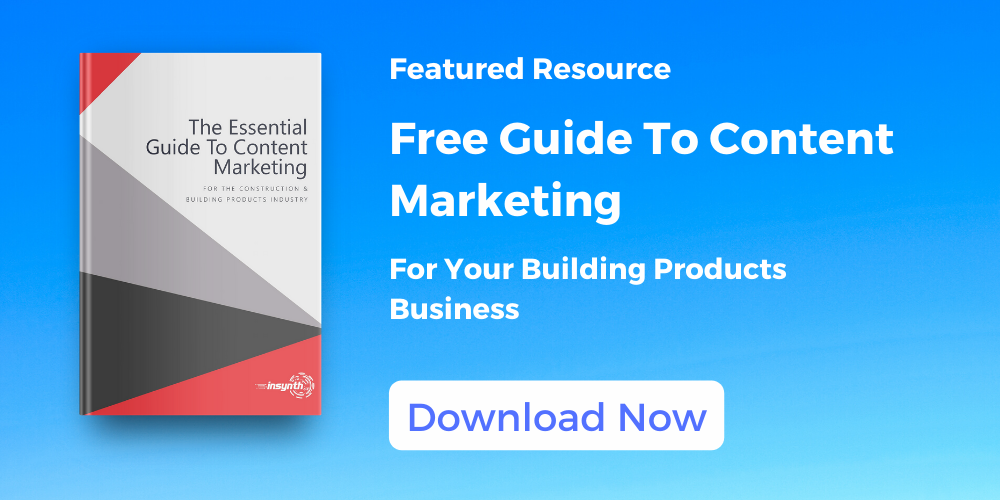
I get it. Building products are technical. That doesn’t mean, however, that they should be dense and difficult to digest.
As an ex-teacher, I know what it’s like to convey information in a simple way. I also know how to make the most technical of subjects readable.
Over the years, I’ve learnt that no matter what industry you’re in, clear communication is central to any successful web project, and your building product blog is no exception.
In this post, you will learn how to take the most technical of subjects, and present it in a simple, ‘plain-English’ way.
Let’s dive in.
The Purpose of Blogging for your Building Product
When it comes to technicality, you must first consider the purpose of a blog post. A blog serves two key functions:
- To improve organic traffic (i.e. to get found online)
- To help specifiers by providing useful content, thus building trusting relationships and thought leadership
Therefore, you’re not going to want to talk too much about your product’s main technical features*. Instead, aim to make your blog accessible with ‘broad appeal’, which is more likely to be seen as a valuable resource.
*You should definitely internally link to your product page, though!
A blog isn’t a product page. It’s a resource that sheds light on your audience’s pain points or helps them improve their practice. Here are some examples of appropriate blog titles:
- X Considerations for Fire Doors in Care homes
- Why LST Radiators are suited to Primary Schools
- How Can Aluminium Decking Improve Hotel Balconies?
Knowing a blog’s purpose will help you to form a clear, SEO-driven content strategy that’s guaranteed to generate impactful results for your building product business.
Write Your Blog With A Pre-Schooler in Mind
I think it was Albert Einstein that said,
“If you can’t explain it simply, you don’t know it well enough.”
I use this phrase time and time again with my clients. In fact, I’m thinking about getting it tattooed soon…
- Why use a long word when a short one will do?
- Full stops are great. Use them more often.
- White space is scientifically proven to help boost reading comprehension…
…Yet so many building product companies commit those three cardinal sins:
- Long words
- Complex sentences
- Dense paragraphs
So, next time you write a blog post – or any form of website copy – ask yourself,
Will an eight-year-old understand it?
Real-Life Examples are Key
When you are presenting technical or complex material in your blog, one of the most effective ways to convey information is to use examples that specifiers can relate to.
If you have a real-life story about why finishing a fire door on site is a bad idea, for example, your blog post is a great place to showcase it.
It’s also a good opportunity to link to a case study.
Keep It Simple. Include Links to Further Materials
A big mistake that we often see is when people try to tackle too many topics within one blog post.
We recommend keeping the information bite-sized and breaking big topics down into sections or even a series of posts.
Linking to related blog posts is a great way to get more value out of your website’s content. You can do this contextually – as in, hyperlinking text in a sentence – or you can callout posts for further reading at the end of your blog.
You can even do both of these things. In fact, we urge you to do both of these things. It’s great for SEO.
According to YOAST,
“Internal links connect your content and give Google an idea of the structure of your website. They can establish a hierarchy on your site, allowing you to give the most important pages and posts more link value than other, less valuable, pages. So using the right internal linking strategy can boost your SEO!”
Conclusion
Most people skim blogs more than they actually read them.
So formatting your posts to facilitate this is crucial. That means:
- Simple language
- Making your major points stand out visually (like using bullet points, for example)
- Short sentences
- Short paragraphs
- An SEO-optimised content strategy
Website content is an art form often overlooked in the building products industry, but as more specifiers carry out product research online, a well-optimised, well-written website is crucial.
If you’d like to improve your web content, why not talk to one of the experts here at Insynth? Call +44 1952 897 097 or email me: rich@insynth.co.uk
ABOUT INSYNTH
Insynth Marketing is a leading UK construction marketing agency based in Shifnal in the West Midlands.
They use the latest inbound marketing techniques such as construction inbound marketing, to support building product companies to grow their business by proactively driving sales lead generation activity.
As the only HubSpot certified agency to major on construction marketing, we bring together construction marketing strategy, digital strategy, website design, SEO, content marketing, email marketing, sales automation, marketing automation and HubSpot CRM implementation to produce successful campaigns and great results for our clients.

